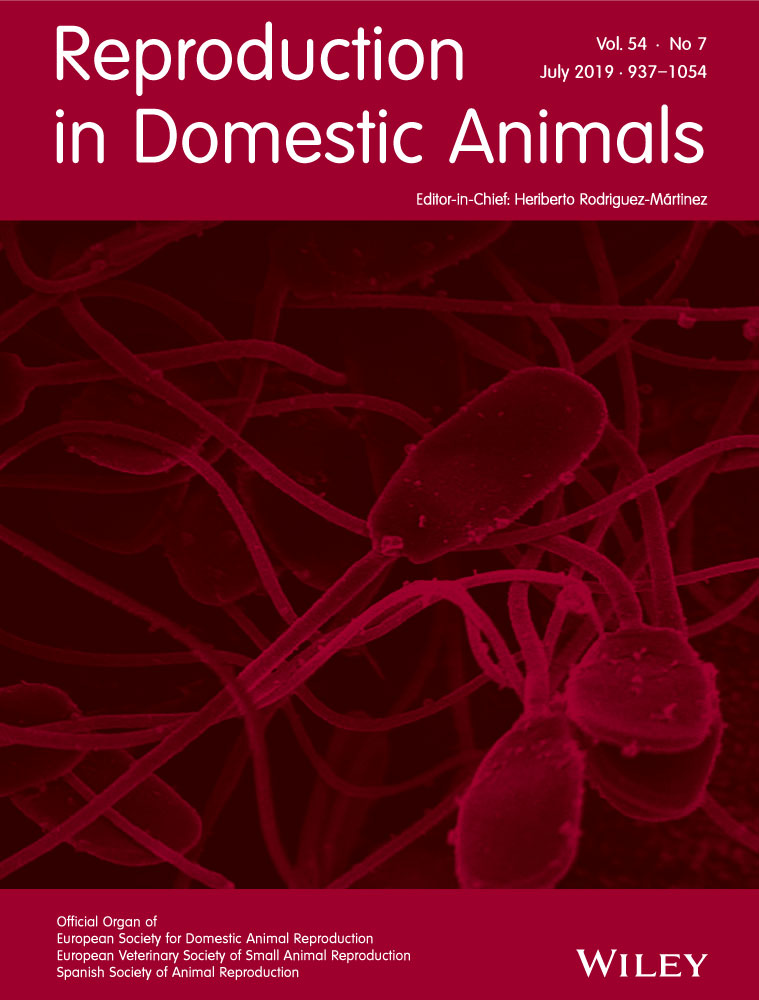Acupuncture prevents the postpartum reduction in matrix metalloproteinase type-2 immunoexpression, tissue concentration and enzyme activity in bovine caruncles
Abstract
The objectives of this study were to determine the effects of acupuncture in dairy cows (Bos taurus) on caruncular matrix metalloproteinase type-2 (MMP2) at 0, 2 and 4 hr after calving. Acupuncture (n = 6) was applied at 0 and 2 hr after calving to 6 points that relax the cervix and stimulate uterine contractions. Controls (n = 9) were kept in a stanchion for 15 min without acupuncture. All of the cows in the study delivered their placenta in <4 hr. Formalin-fixed caruncles were paraffin-embedded and subjected to routine immunohistochemistry to determine MMP2 expression, which was scored by a single observer. Flash frozen caruncles were homogenized, and protein concentration was determined. MMP2 concentrations were calculated using commercial bovine ELISAs. MMP2 enzyme activity was determined using zymography. The mean value for each time point for each cow was used to calculate the mean ± SEM for each treatment group. MMP2 was predominantly localized to the epithelial and subepithelial stromal cells of the caruncles in both treatment groups. MMP2 immunoexpression was lower 4 hr after calving in the control cows (p = 0.012) but not in the acupuncture treated cows indicating that acupuncture treatment maintained MMP expression. MMP2 tissue concentration was lower 2 hr after calving in the control cows (p = 0.048) but not in the acupuncture treated cows. MMP2 enzyme activity decreased from 0 to 2 hr after calving in control cows (p = 0.046) but not in acupuncture treated cows. This study provides physiologic evidence for the effects of acupuncture on the bovine reproductive tract and substantiates the use of this treatment in cases of placental retention.
1 INTRODUCTION
The bovine placenta is comprised of two membranes: the allantochorion and the amnion. The allantochorion is formed from a collection of placentomes. Each placentome contains a foetal part (cotyledon) and a maternal part (caruncle). Each bovine allantochorion typically has 100–150 placentomes. Normal separation of the cotyledon and caruncle is mediated by various biochemical reactions. Tissue proteases, mainly matrix metalloproteinases, contribute to remodelling of epithelial, stromal and placental tissues during gestation as well as after calving (Hashizume et al., 1997). Specifically, matrix metalloproteinase type-2 (MMP2) acts to release the cotyledon from the caruncle after calving by breaking down collagen (Dilly et al., 2011; Hashizume et al., 1997; Maj & Kankofer, 1997). Normally, the placenta is released from the uterus within 6–12 hr of calving. If MMP2 is absent or reduced, this can cause placental retention due to a lack of collagenase activity (McNaughton & Murray, 2009).
In cattle (Bos taurus), placental retention is defined as the failure to deliver all or part of the placenta within 24 hr after calving (Qu, Fadden, Traber, & Bobe, 2014). In dairy cattle, the herd incidence of placental retention ranges between 5.2% and 23.5% (Erb, Hinze, Gildow, & Morrison, 1958; Kennedy, 1947; Majeed & Qassim, 1989; Moller et al., 1967). Placental retention in dairy cattle results in serious animal health and welfare problems as well as has a significant economic impact for producers. Projected milk loss due to placental retention is roughly 1,657 pounds per cow (over 305 days in milk; Dubuc, Duffield, Leslie, Walton, & Leblanc, 2011). Placental retention increases the calving-to-conception interval by up to 51 days and almost doubles the average number of services per pregnancy (LeBlanc, 2008). Cows with placental retention are also more likely to have uterine infections, hoof problems and mastitis (Larson, Ishak, Owen, Erickson, & Lowry, 1985).
The aetiology of placental retention can fall into three general categories. The first aetiology results from increased blood pressure within the chorionic villi, which can occur following caesarean section or uterine torsion (McNaughton & Murray, 2009). This results in abnormal mechanical separation of the cotyledon from the caruncle. The second cause of placental retention is uterine atony. This can be due to excessive stretch of the myometrium from several previous pregnancies (Dalrymple, Mahn, Poston, Songu-Mize, & Tribe, 2007; McNaughton & Murray, 2009). Uterine atony can also occur from hypocalcaemia or “milk fever” (Muller & Owens, 1974). The third reason for placental retention is cellular dysfunction related to down-regulation of pro-MMP2 or absence of MMP2 (Maj & Kankofer, 1997; McNaughton & Murray, 2009). This can reduce collagen breakdown and result in abnormal enzymatic separation.
Research carried out within the past 20 years suggests that there is a physiologic basis for placental retention but the treatment and prevention of this condition continue to elude dairy producers and veterinarians. Manual removal results in a greater risk of uterine infection and prolonged interval from calving to first functional corpus luteum (Bolinder, Seguin, Kindahl, Bouley, & Otterby, 1988). Intrauterine antimicrobial therapy is indicated to treat a secondary uterine infection but does not improve milk yield or reproductive performance (Goshen & Shpigel, 2006; Gunay, Gunay, & Orman, 2011). In addition, administration of prostaglandin F2alpha or oxytocin does not reduce the incidence of placental retention (Stevens & Dinsmore, 1997). However, infusion of collagenase into the umbilical vessels is an effective treatment for placental retention because the breakdown of collagen is necessary for placental detachment (Eiler & Hopkins, 1993).
Acupuncture is accepted by some dairy producers as an alternative treatment for a variety of reproductive conditions including delayed uterine involution, repeat breeding, dystocia and uterine infections (Chan, Chen, Liu, WuU, & Lin, 2001; Habacher, Pittler, & Ernst, 2006; Lin, Chan, & Wu, 2001). To date, there have been no peer-reviewed studies investigating the use of acupuncture as a complementary treatment for placental retention in dairy cows. However, acupuncture has been used as a complementary treatment for the condition of placental retention in humans (Bobić & Habek, 2012). Acupuncture increases uterine blood flow (ref) which is speculated to increase MMP2 activation. Although changes in uterine MMP2 concentration and activity following acupuncture treatment have not been investigated, we hypothesized that acupuncture would increase caruncular MMP2 immunoexpression, tissue concentration and enzyme activity in dairy cows, thereby facilitating placental release. The objectives of this study were to measure caruncular MMP2: (a) immunoexpression using immunohistochemistry, (b) tissue concentration using an enzyme-linked immunosorbent assay (ELISA) and (c) enzyme activity using gelatin zymography.
2 MATERIALS AND METHODS
2.1 Animal husbandry and sample collection
This study was approved by the Oregon State University (OSU) Institutional Care and Animal Use Committee (ACUP # 4570), and the standards outlined in the ADSA-ASASPSA Guide for Care and Use of Agricultural Animals in Research and Teaching were followed. Placentomes were collected from 15 freshening Holstein and Jersey cows housed at the OSU Dairy Center. Cows were fed a TMR diet and water ad libitum. Dry cows were kept in free stall housing and fed a TMR diet containing 48% haylage, 10.20% grass silage, 33.86% corn silage, 7.72% alfalfa and 0.23% minerals. Close-up cows were moved to individual pens 2–3 weeks before calving and fed the same diet without minerals. Close-up cows were monitored continuously for signs of calving.
Immediately after a natural (spontaneous, term) calving, each cow was restrained in a stanchion and the vulva and perineal area was aseptically prepared. A caruncle was obtained transvaginally from the body of the uterus as described by McNeel, Ondrak, and Cushman (2013) using a placentome attainment device at 0, 2 and 4 hr after normal calving. This method for placentome collection is associated with no morbidity and has had no significant effects on fertility (McNeel et al., 2013).
After placentome collection, the foetal membrane (cotyledon) was removed from the caruncle by gentle manual separation. Half of the caruncular tissue was fixed in 10% neutral buffered formalin, and the other half was flash frozen in liquid nitrogen and stored at −80°C until processed. Caruncle sample collection was repeated two additional times at 2 and 4 hr after calving (for a total of three caruncles collected). The duration (in hr) from calving until the placenta was delivered was recorded.
2.2 Acupuncture protocol
Cows were randomly assigned to the acupuncture or untreated (control) group (Table 1). Acupuncture treatment was administered to cows (Holstein: n = 2 cows, Jersey: n = 4 cows) after caruncle collection at 0 and 2 hr after calving. Untreated controls (Holstein: n = 2 cows, Jersey: n = 7 cows) were kept in a stanchion for 15 min without any stimulation. While standing in a stanchion, acupuncture needles (30 × 0.30 mm; No. 8; J type; Seirin Corporation) with a guide tube were placed into cows and left in place for 15–20 min. Acupuncture was applied to six points: bladder (BL) 31, 32 and 34, Baihui (lumbosacral space, DU 20), Guanyuanshu (BL 26) and governing vessel (GV)-1 (Figure 1). Baihui, BL 31, BL 32, and BL 34 and BL 26 were selected as these points relax the cervix and stimulate uterine contractions in cows (Lin et al., 2001). Baihui and GV-1 are points to move the Qi (energy) and resolve stagnation (Xie, 2007). In addition, the Baihui acupuncture point is known as the “point of 100 meetings” where all the Yang meridians merge and has been used as a complementary treatment in dairy cows for anoestrus, cystic ovaries, retained or cystic corpus lutea, silent oestrus, pseudopregnancy, inflammation of the reproductive tract, uterine prolapse, prevention of abortion or to induce parturition (Lin & Panzer, 1992). For a complete description of the various acupuncture locations (points) and pathways (meridians) used in cattle, the reader is encouraged to review Thompson (2017).
| Cow number | Treatment group | Lactation number | Milk yield at last lactation (lbs) | Previous retained placenta? |
|---|---|---|---|---|
| 474 | Control | 2 | 13,260 | No |
| 16 | Control | 4 | 14,520 | No |
| 454 | Control | 3 | 12,740 | No |
| 481 | Control | 1 | N/A | N/A |
| 483 | Control | 1 | N/A | N/A |
| 115 | Control | 3 | 16,770 | No |
| 472 | Control | 2 | 17,300 | No |
| 14 | Control | 5 | 12,460 | No |
| 1004 | Control | 3 | 15,500 | No |
| 494 | Acupuncture | 1 | N/A | N/A |
| 493 | Acupuncture | 1 | N/A | N/A |
| 768 | Acupuncture | 1 | N/A | N/A |
| 486 | Acupuncture | 1 | N/A | N/A |
| 159 | Acupuncture | 1 | N/A | N/A |
| 497 | Acupuncture | 1 | N/A | N/A |
- Note: N/A, not applicable.
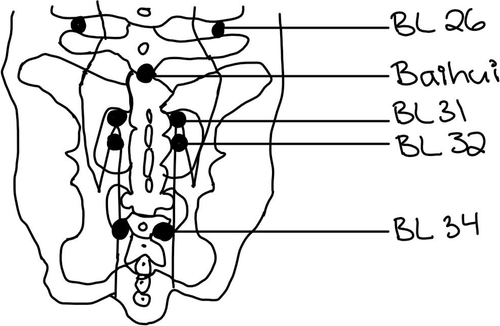
2.3 MMP2 immunohistochemistry
The formalin-fixed caruncles were paraffin-embedded, sectioned to 6 μm and mounted on poly-l-lysine-coated slides. Expression of MMP2 (1:1,000 dilution; #LS-B2799; LifeSpan Biosciences) in the caruncle was then determined using routine immunohistochemistry following enzymatic epitope retrieval (proteinase K; #S3020; Dako). Negative controls from each tissue were treated with a universal negative antibody (#N1699; Dako). Slides were then reacted with One Step Horse Radish Peroxidase-Conjugated Polymer Anti-Rabbit IgG (#IH-8064-custom-OrSU; ImmunoBioScience) followed by Nova Red Peroxidase substrate (#SK4800; Vector Laboratories). Slides were counter-stained with haematoxylin (#S3302; Dako), dehydrated and mounted. Utilizing bright-field microscopy, images were digitally captured at 400× magnification. At 50× magnification, immunoexpression of MMP2 was scored across four quadrants of the caruncle based on per cent of cellular expression and staining intensity by a single observer (LG).
2.4 Caruncle protein extraction
Frozen caruncle tissue samples were homogenized on ice and centrifuged as previously described by Zervos et al. (2000). Briefly, tissue samples were cut into 0.5 cm3 pieces and combined with approximately 1.5 ml of solubilization buffer. Samples were homogenized on ice using a BioSpec Tissue Tearor (model 985-370) and then centrifuged at 10,000 g for 10 min at 4°C. The supernatant was collected, and a single total protein concentration was determined from each sample using the Stanbio LiquiColor kit (#0345; Stanbio Laboratory) per manufacturer's instructions on a 96-well plate reader (BioTek Instruments EL800 Microplate Reader) at 550 nm. A ratio of 50 μl sample or standard to 150 μl reagent was used. A five-point standard curve was created using the KC-Junior software (BioTek) to determine total protein concentration of each caruncular homogenate sample. Samples were then stored at −80°C until further analysis.
2.5 MMP2 enzyme-linked immunosorbent assays
Concentrations (pg/ml) of MMP2 were calculated from caruncular homogenates run in triplicate using a commercial assay specific for bovine (Nori® Bovine MMP2 ELISA; Genorise Scientific, Inc.) in accordance with the manufacturer's instructions. Each 96-well plate was read at 450 nm with a wavelength correction set to 540 nm. The assay sensitivity was 32 pg/ml with an intra- and inter-assay CV of 5% and 9%, respectively. A standard curve was created by mars Data Analysis Software (BMG Labtech) to calculate MMP2 concentrations.
2.6 Gelatin zymography
Gelatin zymography was used to measure enzymatic activity of matrix metalloproteinases as previously described by Heussen and Dowdle (1980) and Chamberlin (1995). In a subset of gels, ethylenediaminetetraacetic acid (EDTA; catalog #E-5134; lot #039K0108; Sigma-Aldrich) was added to the incubation buffer to determine which gelatinases were zinc-dependent. Two gels containing the same samples were run together and treated the same, except 1 was incubated in incubation buffer containing 10 mM EDTA. The chelating activity of EDTA in the buffer would have sequestered zinc, an essential metal ion in matrix metalloproteinases, rendering the enzyme inactive. Enzymatic activity was then quantified using digital camera and true 16-bit data capture system (Gel Logic 2200 Pro; Bio-Techniques). Intensity was normalized using the highest molecular mass type-4 collagenase band intensity for each individual gel. Band intensities indicate enzyme activity for each gelatinase.
2.7 Statistical analyses
The average MMP2 immunoexpression score for each time point in each individual was used to calculate the average ± SEM for each treatment group. The mean ± SEM MMP2 concentration for each time point was determined. The mean MMP2 band intensity for each time point in each molecular mass category was used to calculate the mean ± SD for each time point. Repeated measures analysis of variance (graphpad prism7®) was used for all statistical comparisons. Corrections for multiple comparisons were made by controlling the false discovery rate using the two-stage linear step-up method of Benjamini, Krieger, and Yekutjeli (2006). Differences at values p < 0.05 were considered statistically significant.
3 RESULTS
No cows (0%) in this study retained their placenta (all cows delivered their placentas within 4 hr after calving). Immunoexpression of MMP2 (Figure 2) was predominately localized to the epithelial and subepithelial stromal cells of the caruncles in both treatment groups. MMP2 immunoexpression did not differ between control and acupuncture treated cows at calving or 2 hr after calving (after the first treatment; Figure 3). However, MMP2 immunoexpression was lower 4 hr after calving in the control cows (p = 0.012) but not in the acupuncture treated cows, indicating that acupuncture treatment maintained MMP expression. In addition, MMP2 tissue concentration in control cows was reduced at 2 hr after calving (p = 0.048) compared to the time of calving (Figure 4). Yet, similar to the MMP2 immunoexpression, the MMP2 tissue concentration in the acupuncture treated cows did not change from the time of calving to either 2 or 4 hr after calving compared to the time of calving.
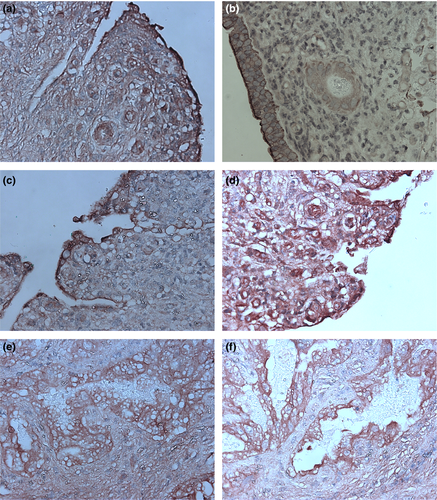
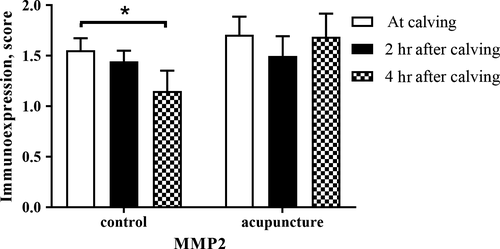
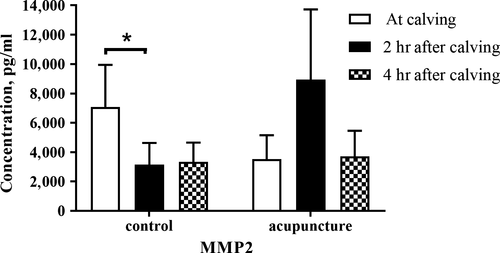
Five distinct zinc-dependent gelatinases (234, 143, 117, 59 and 49 kDa) were found in the bovine caruncle at 0, 2 and 4 hr after calving (Figure 5). Consistent with the previous findings, there was a decrease in enzyme activity of the 49 kDa gelatinase, which represents MMP2, 2 hr after calving compared to baseline in control cows (p = 0.046; Figure 6). The activity of this gelatinase in the acupuncture treated cows also did not change 2 or 4 hr after calving compared to the time of calving. The data that support the findings of this study are available from the corresponding author upon reasonable request.
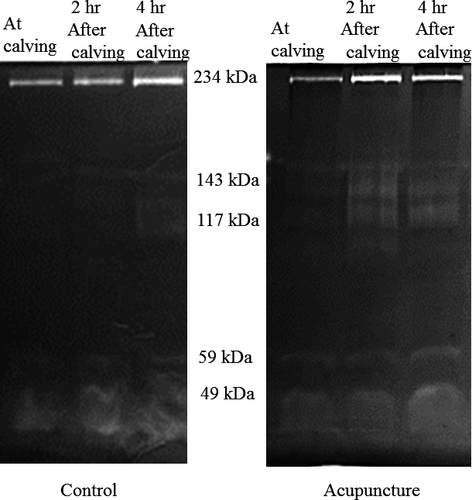
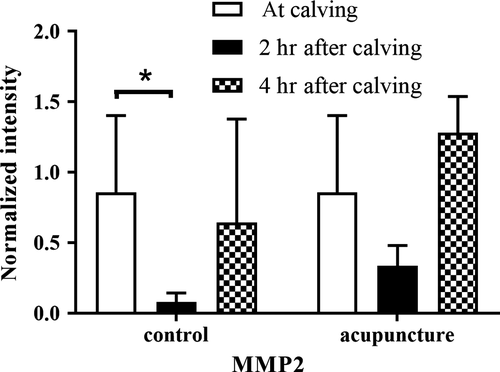
4 DISCUSSION
In the present study, MMP2 immunoexpression, tissue concentrations and enzyme activity decreased after calving in control cows, which is consistent with previous work showing MMP2 gene expression decreases rapidly after calving (Kizaki et al., 2008). Caruncular MMP2 expression is important for placental release as low MMP2 activity has been reported in cows with placental retention (Maj & Kankofer, 1997). The maintenance of MMP2 expression is associated with increased collagenase activity in the bovine endometrium. Collagen breakdown is important in the process of placental release as shown by the successful use of collagenase treatment for placental retention (Eiler & Hopkins, 1992, 1993). In the current study, acupuncture treatment at the time of calving and 2 hr after calving maintained MMP2 immunoexpression, tissue concentration, and enzyme activity until at least 4 hr after calving (Figures 2-4).
The direct effects of acupuncture are not fully known, but there are many proposed mechanisms. The principles of Traditional Chinese Medicine are based on the belief that all things consist of two opposing forces: Yin and Yang (Nicol, 1985). Disease is the result of an imbalance between Yin and Yang. Vital energy (or Qi) flows between the body organs through channels (or meridians) that can be measured as impedance values or electrical resistance. In the case of disease, this energy flow is disturbed and abnormal impedance values can be recorded (Nicol, 1985; Sagrjadski, Slokasow, Rosanow, & Bystrow, 1996). Acupoints are located at sites that have a high density of neurovascular structures and are generally between or at the edges of muscle groups, where needle sticks are less painful. The mere presence of a foreign body (the needle) may act to stimulate vascular factors, including local mediators of inflammation, and activate the adrenal cortex (Rubik, 1995). This leads to an increase in blood flow to the target area. Previous studies have documented increased uterine blood flow following acupuncture treatment in rats and humans (Chang, Chung, & Rosenwaks, 2002; Uchida & Hotta, 2008). MMPs are secreted as proenzymes (pro-MMPs). The main activation of MMP2 is mediated by membrane-type MMPs (MT-MMPs) located on the cell surface (Visse & Nagase, 2003; Zitka et al., 2010; Figure 7). Our proposed mechanism of acupuncture on placental release is that increased blood flow leads to increased activation of MMP2 which leads to separation of the cotyledon and caruncle.
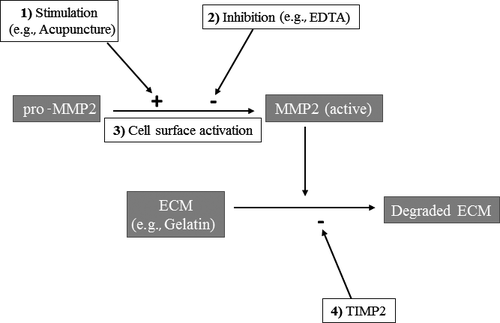
These results provide physiologic evidence for the effects of acupuncture on the bovine reproductive tract. Dairy producers and their support staff can be trained to administer this acupuncture treatment to cows after calving to reduce (or possibly eliminate) postpartum problems associated with placental retention. However, the effects of acupuncture on MMP2 expression, concentration or activity in cows with placental retention are not known and additional research in this area is warranted. Future studies should include a large-scale comparison of this acupuncture treatment versus conventional treatments on cows with placental retention.
5 CONCLUSION
This study found that compared to untreated controls, acupuncture administered to normal cows after calving maintained elevated MMP2 immunoexpression, tissue concentration and enzyme activity. This persistent elevation is associated with increased collagenase activity in the bovine endometrium, resulting in separation of the caruncle from the cotyledon. However, these effects of acupuncture on cows with placental retention are not known and additional research in this area is warranted.
ACKNOWLEDGEMENTS
This project was funded by the United States Department of Agriculture-National Institute of Food and Agriculture (Animal Health project #ORE00141) and Oregon State University's DeLoach Work Scholarship and Undergraduate Research, Innovation, Scholarship and Creativity (URISC).
CONFLICT OF INTEREST
The authors disclose no potential or actual conflicts of interest related to the research presented.
AUTHOR CONTRIBUTIONS
Katrina Hiebel developed the gelatin zymography protocol and collected the data on enzymatic activity, ran the ELISAs, did data analysis and drafted the paper. Lauren Gentle performed the immunohistochemistry protocol and collected the data on immunoexpression. Alfred Menino helped develop and perfect the gelatin zymography protocol as well as the data analysis for enzyme activity. Michelle Kutzler was the principle investigator on this project. She applied for funding, performed the acupuncture treatment, collected the caruncle samples and assisted in all other parts of the project.



